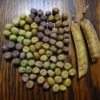Späth’s Alblinse I “Die Große”
$4.00
(Lens culinaris)
This lentil very much impressed me. The seeds look like any other green lentil, but the plants are strikingly different from any other lentil I have grown: they are taller, about 12-14”/30-40 cm, have beautiful purple flowers, and have long pods with 7-9 seeds, rather than the one or two normal for lentils. This variety is sufficiently impressive to nearly convince me that, with the right genetics, it might be possible to grow lentils in Ontario (though I will need to test it for a few more years before I am convinced).
This variety comes with an interesting history, which I am still exploring. Here is what I know so far: apparently lentils were once raised in the Swabian Alb in southern Germany, a region which has similar limestone-based soils and rainfall patterns to my own. Lentils were a nitrogen-fixing crop, and so they were grown on poor, marginal soils. This lentil was apparently bred in Haigerloch, Germany by Fritz Späth for those conditions in that place (hence the name). However, in the late 1940s and early 50s as agriculture mechanized and artificial fertilizers became widespread, lentils were replaced by higher-yielding crops. Several decades later, rising customer demand for local, plant-based foods encouraged farmers to attempt lentil growing again. By that time, though, the local varieties were extirpated, and they had to grow varieties from France instead. In 2006, one of the farmers in Alb-Leisa, an organic growers’ cooperative, located seed of this variety in the collection of the Vavilov Institute (the All-Russian Institute of Plant Genetic Resources Named After N. I. Vavilov) in St. Petersburg, Russia. Over the next few years, they grew out the seed they received, and in 2012 began to sell it again.
A question which intrigues me in this story is how the Vavilov Institute originally acquired the variety. According to their records, they collected it (as accession K-2076) from Czechoslovakia in 1963. I would love to know the story of how and when it got there, since Swabia is in what was West Germany at the time, and the Cold War was near its height.
108 days to maturity.
125 seeds/packet.
Out of stock
Plant 2 weeks before last frost date, 1- 1 ½” deep and 1” apart, thinned to 4” later; like dry, cool conditions. Tie to trellising to keep pods off the ground. Harvest when bottom third of pods have turned brown and rattle when shaken.






